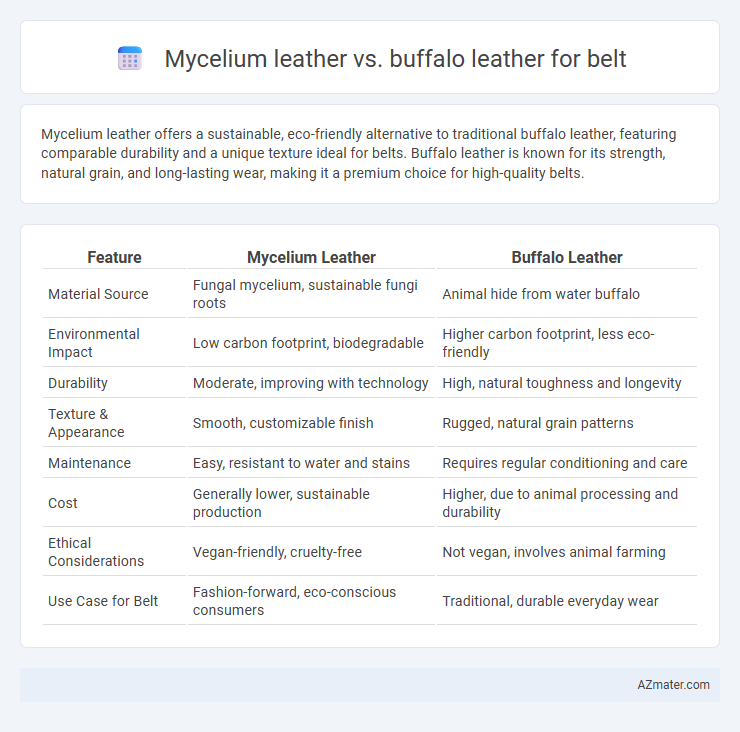Mycelium leather offers a sustainable, eco-friendly alternative to traditional buffalo leather, featuring comparable durability and a unique texture ideal for belts. Buffalo leather is known for its strength, natural grain, and long-lasting wear, making it a premium choice for high-quality belts.
Table of Comparison
| Feature | Mycelium Leather | Buffalo Leather |
|---|---|---|
| Material Source | Fungal mycelium, sustainable fungi roots | Animal hide from water buffalo |
| Environmental Impact | Low carbon footprint, biodegradable | Higher carbon footprint, less eco-friendly |
| Durability | Moderate, improving with technology | High, natural toughness and longevity |
| Texture & Appearance | Smooth, customizable finish | Rugged, natural grain patterns |
| Maintenance | Easy, resistant to water and stains | Requires regular conditioning and care |
| Cost | Generally lower, sustainable production | Higher, due to animal processing and durability |
| Ethical Considerations | Vegan-friendly, cruelty-free | Not vegan, involves animal farming |
| Use Case for Belt | Fashion-forward, eco-conscious consumers | Traditional, durable everyday wear |
Introduction to Mycelium and Buffalo Leather
Mycelium leather, derived from the root structure of fungi, offers a sustainable and biodegradable alternative to traditional animal hides. Buffalo leather, known for its durability and rich texture, is a popular choice for belts due to its strength and long-lasting quality. Both materials provide unique benefits, with mycelium emphasizing eco-friendly innovation and buffalo leather delivering proven resilience.
Production Process: Mycelium Leather vs Buffalo Leather
Mycelium leather is produced through the cultivation of fungal root structures, where mycelium is grown on agricultural waste under controlled conditions, resulting in a sustainable, biodegradable material with minimal environmental impact. Buffalo leather, by contrast, involves the traditional tanning process using animal hides, which requires significant water, chemical use, and energy, often generating harmful waste. The mycelium leather production significantly reduces resource consumption and pollution compared to the more resource-intensive and pollutive buffalo leather tanning process.
Sustainability and Environmental Impact
Mycelium leather offers a highly sustainable alternative to traditional buffalo leather by utilizing fungal roots that require significantly less water, land, and energy during production, resulting in a lower carbon footprint. Buffalo leather production involves intensive livestock farming that contributes to deforestation, methane emissions, and high water consumption. Choosing mycelium leather belts supports eco-friendly practices and reduces reliance on animal agriculture, aligning with environmentally conscious consumer trends.
Durability and Longevity Comparison
Mycelium leather offers impressive durability due to its fungal network structure, resisting wear and tear while maintaining flexibility, though it is generally less tested than traditional materials. Buffalo leather is renowned for its exceptional toughness and longevity, with natural resistance to scratches and moisture, making it ideal for belts subject to daily heavy use. When comparing lifespan, buffalo leather typically outperforms mycelium leather, enduring years of consistent wear without significant degradation.
Aesthetic and Texture Differences
Mycelium leather offers a unique, organic texture featuring a subtle, fibrous pattern that provides a matte finish, contrasting with buffalo leather's naturally rugged grain and glossy sheen. Buffalo leather boasts a denser, slightly rough surface with prominent pores and creases, delivering a traditional, robust aesthetic ideal for durable belts. The softer, more pliable feel of mycelium leather enhances contemporary, eco-friendly designs, while buffalo leather retains a classic, masculine appeal through its tactile firmness and natural markings.
Comfort and Flexibility in Belts
Mycelium leather offers superior flexibility compared to buffalo leather, making it ideal for belts that require easy bending and a comfortable fit throughout the day. Buffalo leather, while durable and sturdy, tends to be thicker and less pliable initially, which can result in a break-in period before achieving optimal comfort. The breathable nature of mycelium leather enhances comfort by reducing moisture buildup, a feature not typically found in traditional buffalo leather belts.
Cost and Market Availability
Mycelium leather offers a sustainable and cost-effective alternative to traditional buffalo leather, with lower production costs due to its rapid growth and minimal resource requirements. Buffalo leather remains more widely available in the market, benefiting from established supply chains and consumer familiarity, but often carries higher prices driven by animal rearing and processing expenses. The growing demand for eco-friendly materials is increasing the market presence of mycelium leather belts, although buffalo leather still dominates due to its durability and luxury perception.
Ethical Considerations and Animal Welfare
Mycelium leather offers a sustainable alternative to buffalo leather, as it is cultivated from mushroom roots without harming animals, significantly reducing environmental impact and ethical concerns tied to animal slaughter. Buffalo leather production involves raising and processing animals, which raises issues related to animal welfare, factory farming conditions, and greenhouse gas emissions. Choosing mycelium leather for belts supports cruelty-free fashion and aligns with growing consumer demand for vegan and eco-friendly materials.
Maintenance and Care Requirements
Mycelium leather requires less maintenance than buffalo leather, as it is naturally resistant to water and stains, reducing the need for frequent cleaning or conditioning. Buffalo leather, while durable, demands regular application of leather conditioners to prevent drying and cracking, especially when exposed to moisture or direct sunlight. Both materials benefit from proper storage in a cool, dry place to extend the belt's lifespan and maintain its appearance.
Choosing the Best Leather for Your Belt
Mycelium leather offers a sustainable and eco-friendly alternative to traditional buffalo leather, featuring a lightweight and flexible texture ideal for comfortable belts. Buffalo leather boasts exceptional durability, natural water resistance, and a rugged appearance that develops a unique patina over time, making it a preferred choice for long-lasting belts. When choosing the best leather for your belt, consider mycelium leather for sustainability and modern style, whereas buffalo leather suits those prioritizing strength and timeless aesthetics.

Infographic: Mycelium leather vs Buffalo leather for Belt
 azmater.com
azmater.com